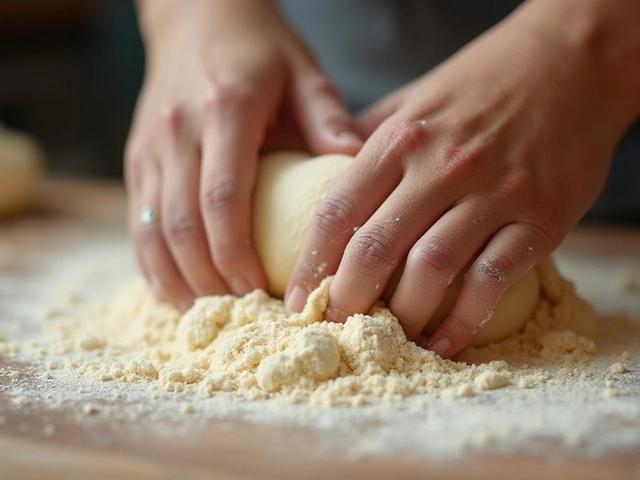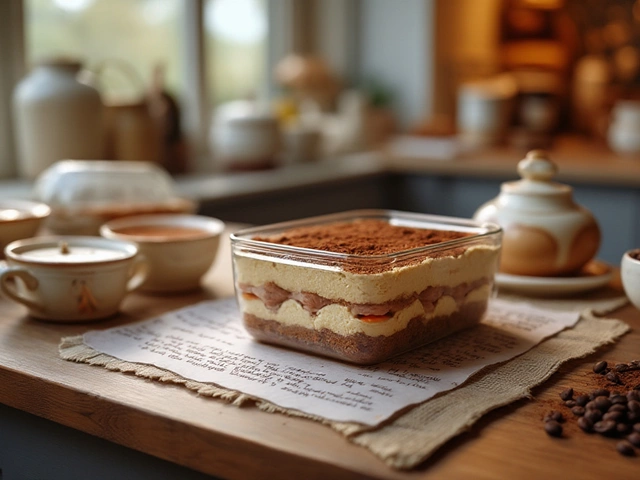
Wondering if you can walk into a bakery in Barcelona and ask for a 'brownie' without getting weird looks? The short answer: yes, you can. In fact, in most Spanish-speaking countries, people just say 'brownie.' It’s kind of like how words like 'pizza' or 'sandwich' hopped languages without anyone bothering to translate.
But here’s the catch—'brownie' isn’t really a Spanish word. It sounds English and feels a bit out of place next to 'tarta' or 'bizcocho.' Still, nobody calls it something else, unless they want to use a longer description. If you’re baking or ordering, just stick with 'brownie.' Saves everyone the confusion. Want to know how Spanish speakers get creative when describing brownies, and what you can do if you’re in a Spanish-only kitchen? Keep reading, it’s surprisingly handy.
- The Term 'Brownie' in Spanish
- How Spanish Speakers Describe Brownies
- Ordering and Baking Brownies Abroad
- Translation Troubles: Literal vs Original Names
- Fun Brownie Facts Across Cultures
- Tips for Talking Brownies in Spanish
The Term 'Brownie' in Spanish
Let’s get something straight: there’s no official Spanish word for brownie. If you walk into a bakery in Madrid, Buenos Aires, or Mexico City, you’ll almost always see 'brownie' written on the menu. It’s borrowed straight from English. Real talk—there isn’t even a close equivalent in the Spanish dictionary, and the Royal Spanish Academy (RAE) doesn’t list a unique word for it. They just accept ‘brownie’ as part of borrowed food terms, the same way 'hamburguesa' for hamburger is now totally normal.
If you’re expecting Spanish speakers to come up with a fancy new term, you’ll be waiting forever. The reason is simple: brownies are a pretty American invention, and when they made their way into Latin America and Spain, people just took the name along for the ride. Some baking books might try to describe it as 'bizcocho de chocolate húmedo' (which means moist chocolate cake), but everyone knows that a brownie is not just another cake. There’s nothing quite like its fudgy, dense bite.
When in doubt, say 'brownie.' You won’t mess up or sound silly, whether you’re in a coffee shop or chatting about desserts with friends who speak Spanish. Sometimes local menus will jazz it up a little—'brownie de chocolate,' for example—just to make it super clear that it’s not vanilla or something weird. But the key word always sticks: brownie is brownie, no translation needed.
How Spanish Speakers Describe Brownies
Walk into a bakery in Mexico, Argentina, or Spain and say "brownie"—no one's going to blink. The word slipped right into Spanish without a makeover. But if you listen closely, you’ll sometimes hear people get creative when they want to explain brownie to someone who doesn't know it, or just want to sound local.
A common way people describe it is “bizcocho de chocolate” (chocolate sponge cake) or “pastel húmedo de chocolate” (moist chocolate cake), but honestly, that doesn’t nail what makes a brownie so good. Brownies are denser and fudgier than most traditional Spanish cakes, so these phrases only get halfway there.
If someone wants to seem extra clear, you might hear: "un cuadrado húmedo y denso de chocolate," which translates to "a moist, dense chocolate square." When talking about texture, folks mention if it’s "fudgy" (pegajoso), "cakey" (esponjoso), or "con nueces" (with nuts). It's all about finding the right balance when someone asks, “¿Qué es un brownie?”
- Brownie (used as is by most Spanish speakers)
- Pastel de chocolate denso (dense chocolate cake)
- Cuadro de chocolate (chocolate square)
- Tarta/bizcocho húmedo de chocolate (moist chocolate cake or sponge)
Chocolate desserts already hold a big spot in Spanish-speaking countries, but brownies get their own niche thanks to their American roots. If you ever see brownies on a menu, the description might mention their size or if they have nuts or frosting. Here's a quick look at how typical brownie descriptions might compare to cakes and other treats in terms of texture and popularity, based on bakery findings:
| Dessert Name | Common Spanish Name | Texture | Popularity in Cafes (%) |
|---|---|---|---|
| Brownie | Brownie | Dense, fudgy | 70 |
| Chocolate Cake | Tarta de chocolate | Soft, spongy | 90 |
| Sponge Cake | Bizcocho | Light, fluffy | 85 |
So, next time you want to describe a brownie in Spanish, try focusing on those key things—dense, fudgy, and chocolate-packed. That always gets the point across, even if there's no true Spanish equivalent for the name.
Ordering and Baking Brownies Abroad
Traveling in Latin America or Spain and craving a brownie? Good news: almost every café, bakery, or coffee shop in big cities knows what you mean when you say "brownie." The word has slipped right into the local language, even if it’s not technically Spanish. Menus in places like Mexico City, Buenos Aires, or Madrid just list them as "brownie." You might notice a fun twist—sometimes you'll spot 'brownie con nuez' (with walnuts), or 'brownie de chocolate' to make it clear they’re chocolate-heavy.
If you’re in a smaller town or a traditional bakery, it can get interesting. The staff might raise an eyebrow unless they cater to tourists or younger crowds. In those cases, just describe it as something like 'pastel de chocolate denso' (dense chocolate cake) or 'tarta de chocolate húmeda' (moist chocolate tart). Still, in most supermarkets, you'll find baking mixes literally labeled "Brownie." Easy, right?
Let’s say you’re the one baking. In Spain and most of Latin America, it’s easier these days to find all the ingredients—cocoa powder, chocolate bars, and nuts are everywhere. But measuring gets tricky. While in the U.S. recipes use cups and sticks, Spanish-speaking countries almost always use grams and milliliters. If you grab a local recipe book, weights look very different to what you may expect back home. Here’s a handy conversion:
| U.S. Measurement | Metric Equivalent |
|---|---|
| 1 cup flour | 120 grams |
| 1 stick butter | 113 grams |
| 1 cup sugar | 200 grams |
| 1 ounce chocolate | 28 grams |
Another thing—baking powder and baking soda sometimes go by different names. Baking powder is "polvo de hornear" and baking soda is "bicarbonato de sodio." Watch those ingredients, since a switchup can seriously mess with your brownies’ texture.
Looking for that classic fudgy feel? Use less flour and a bit more chocolate. Spanish-speaking countries can be heavy on cakey desserts, so if you spot a local brownie looking tall and fluffy, it’s not a mistake—they just like it less dense. And when in doubt, point to a picture, use the English word, or ask for "algo como pastel de chocolate americano." Nobody will judge you for wanting the real thing.

Translation Troubles: Literal vs Original Names
Here’s where things get messy. When it comes to translating food, especially desserts, Spanish speakers don’t always swap in a local word. Take the brownie—nobody wants to call it something clunky like “tarta de chocolate cuadrada y húmeda.” It just sounds weird and confusing. Most folks keep it simple and stick with the English word, even if it feels out of place among words like 'mazapán' or 'churro.'
The same thing happens with other foods. No one calls a 'hot dog' a 'perro caliente' unless they’re joking around or it’s printed on a menu trying to look fancier. But with brownies, if you did want to describe it for someone who had never heard the word, you might say:
- 'bizcocho de chocolate' (chocolate sponge cake)
- 'pastelito de chocolate' (little chocolate cake)
- 'cuadrado de chocolate' (chocolate square)
None of these really match the gooey center or chewy edges that make brownies unique. That’s why the loanword wins every time. And nobody in Spain or Latin America got together and voted for a new word—they just adopted ‘brownie’ because it’s short and easy.
You’ll spot “brownie” on menus across Spanish-speaking countries, but sometimes a café or bakery gets clever and tries new names. In Mexico, for example, you might see “torta brownie” or “brownie de chocolate,” but notice the English word is still there.
Here’s how brownies stack up with other English food words in Spanish:
| Food | Literal Translation | Common Use |
|---|---|---|
| Brownie | Pastel/bizcocho de chocolate | Brownie |
| Hamburger | Hamburguesa | Hamburguesa |
| Hot dog | Perro caliente | Hot dog/perro caliente |
| Cookie | Galleta | Galleta |
The coolest takeaway? Using “brownie” keeps things clear. Literal translations never really caught on because nobody wants a mouthful—literally or linguistically—when they just want dessert. So, next time you bake, don’t stress about translations. Just call it a brownie. Everyone will know what you mean.
Fun Brownie Facts Across Cultures
It’s wild how the brownie took over the world despite coming from a single American cookbook in 1896. That first recipe didn’t even have chocolate—imagine calling that a brownie now! Chocolate brownies only showed up a few years later, but from then on, everyone started making their own versions.
Different countries add their own twist. In Argentina and Mexico, brownies sometimes show up topped with dulce de leche. In Spain, you might spot brownies served with a scoop of vanilla ice cream or with chunks of walnuts inside, which is a solid crowd-pleaser. They keep the English word 'brownie' but adapt the flavors for local tastes. Even in Japan, you’ll find crazy flavors like matcha (green tea) brownies popping up in cafes.
Some people get creative for special diets: in Brazil, you’ll find sweet potato or avocado-based brownies. The UK has seen a boom in 'blondies,' which are like brownies but swapped with white chocolate and brown sugar instead of cocoa.
- The world’s largest brownie, baked in 2017 in Alabama, weighed 106 kilograms and fed a whole lot of happy people.
- September 21 is celebrated as National Brownie Day in the U.S.—a decent excuse to eat an extra slice.
- Average calorie count for a regular 2-inch square brownie is about 130-150 calories, but who really stops at one?
Here’s a quick look at how brownies show up globally:
| Country | Popular Twist | Common Topping |
|---|---|---|
| Argentina | Dulce de leche | Nuts or caramel sauce |
| Japan | Matcha, sweet beans | Powdered sugar |
| Spain | Walnuts inside | Ice cream |
| USA | Fudge center | Chocolate chips |
So no matter where you are, if you spot a brownie, you’re likely in good company. And you might even find a new favorite version.
Tips for Talking Brownies in Spanish
So you want to talk about brownies confidently in Spanish? Here’s the real talk—most Spanish speakers just use the word brownie. No one will blink an eye if you order a “brownie” in Madrid, Mexico City, or Buenos Aires. But sometimes, you might need to describe it or explain what you want, especially if you’re talking to someone who isn’t that familiar with the dessert.
When you need to elaborate, you can use phrases like:
- “pastel de chocolate” (chocolate cake) – Not exactly a brownie, but it gets the point across if there’s no brownie option.
- “bizcocho húmedo de chocolate” (moist chocolate sponge)—Closer to what a true brownie feels like.
- “postre de chocolate” (chocolate dessert)—A safe bet if you’re just looking for anything chocolatey and sweet.
If you’re baking and sharing a recipe, your Spanish-speaking friends will get it if you just call it “brownie.” But a lot of home bakers add a little description, like “brownie de chocolate con nueces” (chocolate brownie with walnuts).
Got allergies or want special add-ins? Use words like “con nueces” (with nuts), “sin gluten” (gluten-free), and “con chocolate extra” (with extra chocolate). If you want a gooey brownie, say “muy húmedo y chocolatado.”
Not sure which word is the most popular? Check this quick glance at how major Spanish-speaking countries refer to the treat:
| Country | Most Common Term |
|---|---|
| Spain | Brownie |
| Mexico | Brownie |
| Argentina | Brownie |
| Colombia | Brownie |
| Chile | Brownie |
Bottom line? Don’t stress translations for this dessert—it’s brownie, everywhere. Just have fun, toss in a simple description if needed, and enjoy your chocolate fix.












Write a comment